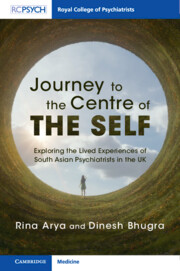 Journey to the Centre of the Self
Journey to the Centre of the Self from Part I - Contextual Information
Published online by Cambridge University Press: 04 October 2024
This chapter examines the predicament outlined in the previous chapter, of the non-white body showing up in white spaces. Whilst a staunch objective of postwar black cultural politics, and of this book itself, is to portray the heterogeneity of the cultural identity of non-white ethnic minorities, in reality what happens in the lived experience is that the individual is interpreted through their racial characteristics, chiefly skin colour, which skews a holistic understanding of the person. The ‘historico-racial schema’ devised by Fanon that defines the restrictions faced by the non-white body in space, is explored in more widely and is theorised in Sara Ahmed’s insights in her study of the phenomenology of whiteness where she conveys the precarious situation of non-white bodies inhabiting white spaces. When they fit in, they are rendered invisible, and when they don’t and ‘stand out’ and ‘stand apart’, they are ‘hypervisible’ (2007, 159). Either way, visibility is not permitted in their own terms. In the interviews that followed the psychiatrists did not enjoy white privilege and there were times when they were made to feel different, a theme that was explored within the context of acculturation and other factors.
To save this book to your Kindle, first ensure [email protected] is added to your Approved Personal Document E-mail List under your Personal Document Settings on the Manage Your Content and Devices page of your Amazon account. Then enter the ‘name’ part of your Kindle email address below. Find out more about saving to your Kindle.
Note you can select to save to either the @free.kindle.com or @kindle.com variations. ‘@free.kindle.com’ emails are free but can only be saved to your device when it is connected to wi-fi. ‘@kindle.com’ emails can be delivered even when you are not connected to wi-fi, but note that service fees apply.
Find out more about the Kindle Personal Document Service.
To save content items to your account, please confirm that you agree to abide by our usage policies. If this is the first time you use this feature, you will be asked to authorise Cambridge Core to connect with your account. Find out more about saving content to Dropbox.
To save content items to your account, please confirm that you agree to abide by our usage policies. If this is the first time you use this feature, you will be asked to authorise Cambridge Core to connect with your account. Find out more about saving content to Google Drive.